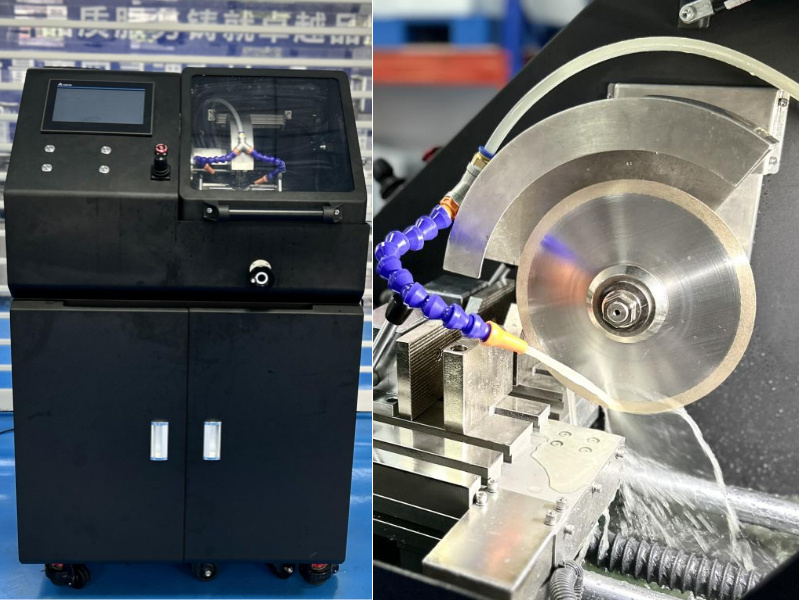When using a precision metallographic cutter to cut workpieces, it is necessary to select cutting blades that match the material properties of the workpiece based on its different materials, so as to achieve efficient cutting results. Below, we will discuss the selection of cutting blades from three perspectives:
1. Selection Based on Material Properties
1) For metallic materials such as steel, iron, and alloys, resin-bonded cutting blades should be used. Their thickness is usually between 1-2 mm, which is suitable for efficient cutting of metallic materials like hardened steel. Heat-Affected Zone is also applicable for precision cutting scenarios such as metallographic analysis. Additionally, the cutting damage can be effectively reduced by adjusting the feed rate.
2) For brittle non-metallic materials such as ceramics and glass, diamond cutting blades are required. These blades have high grain hardness and good thermal conductivity, which can reduce the risk of thermal damage.
3) In the semiconductor, integrated circuit, and PCB industries, ultra-thin precision diamond cutting blades are widely used for quality control and failure analysis.
2. Selection Based on Cutting Surface Requirements and Efficiency Requirements
1) When the workpiece requires no deformation and high surface cleanliness, choose thin cutting blades (thickness: 0.3-1.0 mm). These blades reduce the cutting damage layer and facilitate subsequent grinding processes.
2) When high cutting speed and efficiency are required, choose thick cutting blades (thickness: 1.2-3.0 mm). These blades have high rigidity, are not easy to break, and are suitable for batch cutting.
3.Selection Based on Workpiece Hardness
The hardness of the workpiece directly determines the material selection of the cutting blade. Meanwhile, it is necessary to consider the aforementioned requirements for thin or thick blades (based on surface quality/efficiency). The higher the hardness of the workpiece, the more wear-resistant and rigid the cutting blade needs to be.
1) High-hardness workpieces (>HRC 50, e.g., hardened steel, cemented carbide, high-carbon steel)
Suitable cutting blades: Diamond cutting blades or cubic boron nitride (CBN) cutting blades
Recommended thickness: Priority is given to thick blades (1.2-3.0 mm). They have high rigidity and wear resistance, which can prevent cracking during cutting. High-hardness workpieces tend to wear down ordinary cutting blades, so wear-resistant materials can ensure cutting efficiency; the thick structure is suitable for high-load cutting.
2) Medium-hardness workpieces (HRC 30-50, e.g., ordinary carbon steel, cast iron, stainless steel)
Suitable cutting blades: Resin-bonded diamond cutting blades or high-quality alumina cutting blades
Recommended thickness: Flexible selection — choose thin blades (0.3-1.0 mm) for high surface cleanliness, or thick blades (1.2-3.0 mm) for batch processing. Since the material hardness is moderate, ordinary wear-resistant cutting blades can meet the cutting needs, and thin/thick blades can be matched according to surface quality or efficiency requirements.
3) Low-hardness workpieces (<HRC 30, e.g., aluminum alloy, copper, plastic, wood)
Suitable cutting blades: Ordinary alumina cutting blades or thin diamond cutting blades
Recommended thickness: Priority is given to thin blades (0.3-0.8 mm); 1.0 mm blades can be selected for some materials. Low-hardness workpieces are prone to tool adhesion and deformation; thin cutting blades reduce the contact area, avoiding tool adhesion and workpiece damage. Ordinary cutting blade materials are sufficient to meet the cutting needs.
Final Notes for Cutting Blade Selection:
The cutting effect and service life of general-purpose cutting blades will decrease significantly when used on specific materials.
The cutting blade should be selected according to the configuration of the metallographic cutter in use. For example, avoid using thick cutting blades on low-power cutters as much as possible, as this may easily cause motor overload or cutting blade breakage.

Post time: Nov-12-2025







